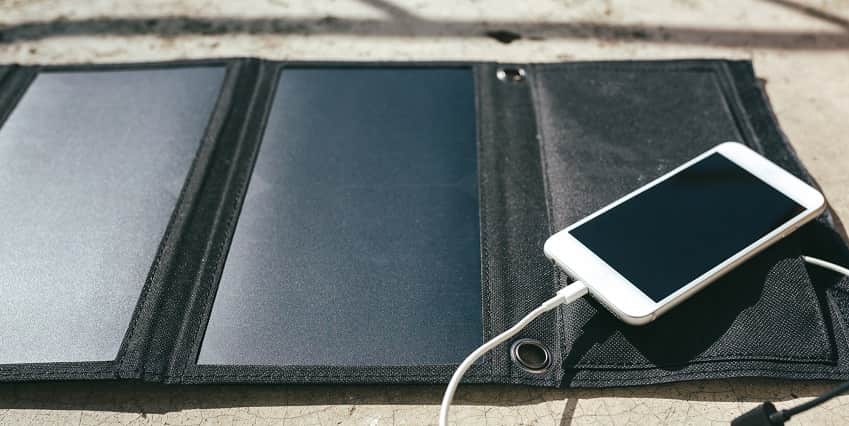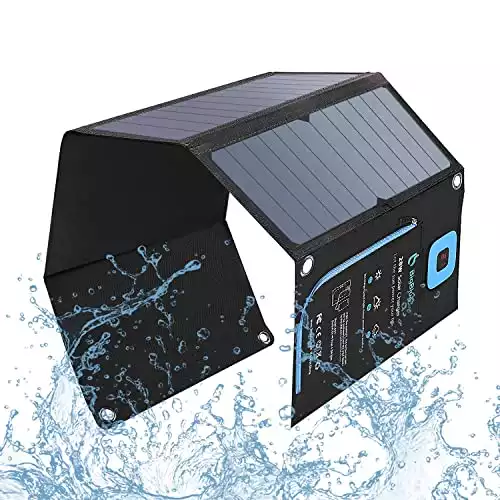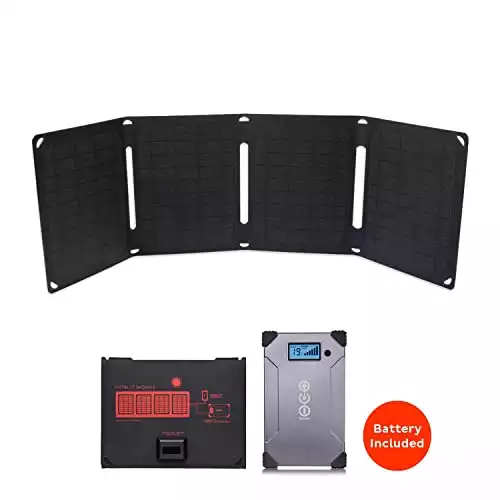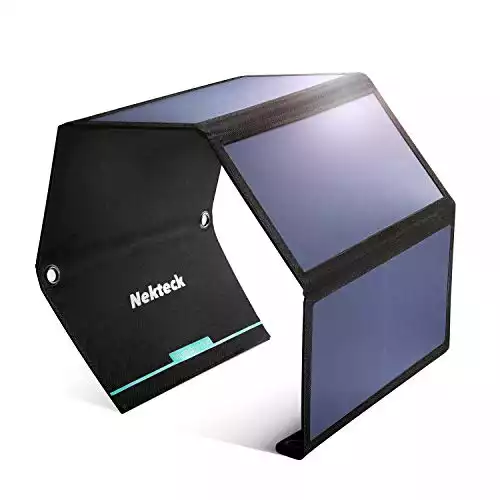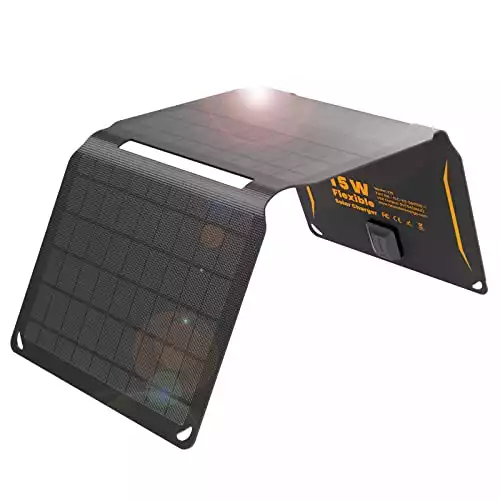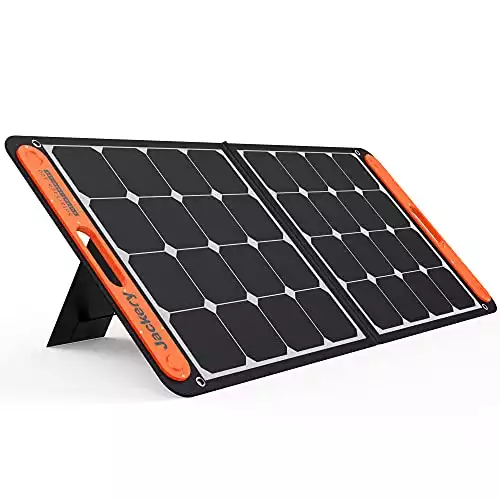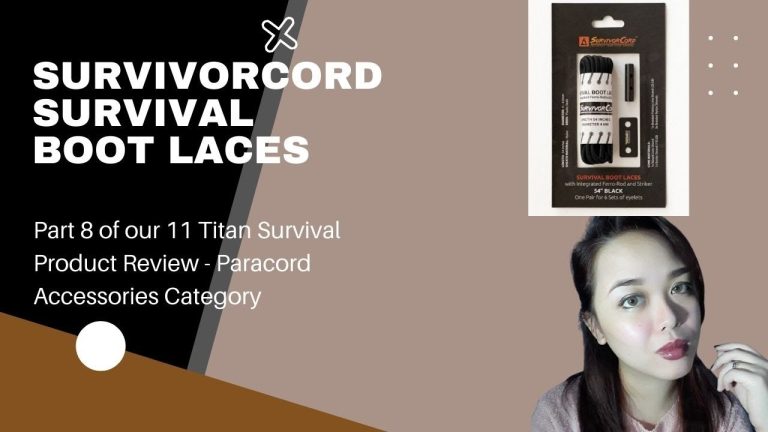Power outages are among the most common emergencies you’ll face and a consequence of almost all major disasters.
A portable power bank will charge your phone for a day or two, but once it’s out of juice, you’ll be stuck in the dark until mains power returns.
That is unless you also have a solar charger. (And some sun.)
Unlike solar power banks, solar chargers don’t usually come with a built-in battery. They’re designed to capture the sun’s energy and convert it into electricity which you can use to charge a power bank or electronic items directly.
In this article, we’ll compare the best portable solar chargers on the market. To be included, they needed to meet our basic criteria:
- Lightweight and portable
- Able to be charged solely by the sun
- Power output greater than 10W
If you want to set up a complete off-grid solar charger system for your house or bug-out location, check out this article; otherwise, let’s dive right in with our top picks.
Portable Solar Chargers vs Solar Power Banks
When browsing for emergency power chargers, you may be tempted to go for a power bank with an integrated solar panel.
Solar power banks store charge, enabling you to use them at night, and they’re often cheaper and smaller than portable solar panels.
However, solar power banks have one huge downside.
They’re not designed to be powered by the sun.
The solar panel is a bit of a gimmick with many power banks. To fully charge the power bank, you need to plug it into mains power, which is great… until there is no mains power.
If you’re going to be off-grid for more than a day or two, a portable solar charger is likely to be your best option for keeping your devices powered on the move.
Everything You Need to Know
Before you whip out your credit card, it’s worth understanding what you’re buying to compare different models.
Portability vs Power
Perhaps your most significant decision is whether to prioritize portability or power generation. As a general rule, the greater the surface area of your solar panels, the more power they’ll generate.
But it also needs to be a realistic size and weight to fit in your Bug Out Bag. Don’t forget that you’ll probably want to include a small power bank in addition to the solar charger itself.
Power is measured in watts (W). The more watts, the more power the panels can generate. It’s worth noting that the power rating for chargers is based on the maximum power of the solar panels, not the power you get out via the USB. Even if you have perfect charging conditions, there will be some losses in the system – this is true for any charger.
High-powered portable solar chargers use a folding design to maximize their surface area while keeping the charger to a reasonable size.
Power Storage
We’re not looking at the small power banks with an integrated solar panel in this article, but some larger solar chargers do come with a compatible battery pack. We’d always recommend you carry a power bank and a solar charger, but as they’re relatively cheap to buy, it’s not a deal-breaker if your solar charger doesn’t come with one included.
Compatibility
With so many different devices and charging standards, it can be challenging to keep track of the many required cables.
Most panels come with the more common cables but always check before buying and test at home before packing into your emergency kit.
Charging speed
The faster you can charge devices, the better, particularly if you can’t leave your solar panels in the sun all day. Typically, high-power chargers will charge items faster than chargers with a lower wattage. Some chargers may incorporate fast-charging technology, such as a USB-C port.
Durability
Portable solar chargers are designed to have a large surface area while remaining lightweight. This inevitably means they’ll be more fragile and prone to damage than a compact solar power bank.
However rugged the manufacturer claims their device to be, the best way of keeping it running is to take good care of it.
When charging, ensure the solar panels won’t accidentally get stepped on or blown off a boulder. Keep the panels clean, and take care when folding and unfolding the charger and packing it in your backpack.
5 Tips to Get Maximum Power from Your Portable Solar Charger
One of the most common complaints about solar chargers is that they don’t deliver the power they claim.
While some of this may be a misunderstanding about the power rating (see above), part of it could be (shock horror!) user error.
Here’s how to get the most out of your solar charger:
- Place it in full sun. Any shade or cloud cover will have a significant impact on your charging time. If you are leaving it out all day, think about how the sun will track across the sky. A spot that gets full sun in the morning may be in the shade by the afternoon.
- Tilt the panels so the sun will hit them at a 90-degree angle. The further you are from the equator, the more you’ll need to tilt the charger.
- Keep the panels clean. If you’re placing your solar charger on the ground or carrying it on the outside of your backpack, it’s likely to pick up dust and dirt. You may be surprised at the effect a simple wipe can have on its charging ability.
- Don’t overcharge your devices. This can be harmful to the battery in your device (shortening its lifespan), and the excess power can heat your solar charger, causing it to deteriorate. Read A beginners guide to batteries.
- Use your solar charger to charge a portable power pack rather than charging devices directly. The power pack will provide a consistent charge for your phone, and you don’t have to worry about the solar panel charge stopping and restarting every time a cloud passes over the sun.
Portable Solar Panels Reviewed
Top Pick: Big Blue 28W
Power: 28W | Folded Size (inches): 6.3 x 11.1 x 1.3 | Weight(lbs): 1.3
Two versions of the Big Blue 28W charger are currently on the market. The original model, one of the few solar chargers to have three USB ports, is well-loved for its performance and reasonable price tag. But the new version has a couple of neat additional features.
You still get four panels with a combined 28W of power but only two USB ports. However, these incorporate intelligent IC technology; this should mean a faster charger per port, so the loss of the 1A port doesn’t amount to much.
Even if you have multiple devices to charge, charging them one at a time will be more effective.
There’s a built-in ammeter to check the current and an internal chip that automatically starts and stops charging if you’re moving in and out of the sun. This helps protect your device and means you can keep items on charge in cloudy or changeable conditions.
On the downside, it’s slightly heavier than other chargers and only comes with a short charging cable. Although there’s a pocket you can secure your phone in, it’s probably safer to get a longer cable and leave it in the shade while you’re charging.
Pros
- IC fast-charging technology
- Built-in ammeter
- Reasonable price
- 24-month warranty
Cons
Best with Power Pack: Voltaic Systems Arc 20W
Power: 20W | Folded Size (inches): 7.5 x 10 x 0.8 | weight (lbs) : 3.25 (inc. power pack)
This is one of the few solar panels with a dedicated power pack. The 24,000mAh battery includes a USB Qualcomm Quick Charger, USB-C Output, and a hi-voltage laptop port and comes with ten different laptop adaptors.
If you have an iPhone or MacBook, you’ll be pleased to know that you won’t require additional cables and shouldn’t have any issues charging your device.
The downside of having a big battery is that it takes a long time to charge up – seven hours in full sunlight – but this is true of any high-capacity power pack.
The design of the solar charger helps, with four panels giving a larger charging area than other models. It’s rugged enough to survive rough conditions and is backed up by a two-year warranty.
Although it looks heavy compared to other models, that’s due to the added weight of the battery. Despite having four panels, it’s smaller and thinner than most of the chargers we’ve reviewed.
The one big downside? The price. But you’re paying for a reliable system that will keep your phone, camera, and laptop charged for months at a time.
Pros
- Can charge phones, tablets, and some laptops
- Durable
- Compatible with Apple products
- Slim design
- Good warranty
Cons
Best On A Budget: Nekteck 28W
Power: 28W | Folded Size (inches): 6.3 x 11.1 x 1.1 | Weight (lbs) – 1.4
The Nekteck 28W solar charger has a lot going for it. It’s lightweight at just over a pound, the canvas packaging is durable, and the panels are rated to IPX4, so you don’t have to worry about passing rain showers.
There’s a handy pocket to store your device in while charging – make sure it doesn’t overheat.
It’s quick to recharge in full sun but doesn’t fare quite so well in cloudy conditions – you may find your phone pings to let you know it’s charging, then not charging, then charging again, which can get a little frustrating.
You can charge two devices via the 2A USB ports (combined 3A current), but charging one device at a time will be quicker.
Pros
- Great value
- 2 USB ports
- Lightweight, durable design
- Attachment points for connecting to backpack
Cons
- Not great in intermittent sun
- No option for fast charging
Best For Backpacking: FlexSolar 15W
Power: 15W | Folded Size (inches): 23.5 x 8.8 x 0.1 | Weight (lbs): 0.99
If you’re prioritizing weight, the FlexSolar 15W charger is one of the lightest on the market. It’s not as powerful as the Big Blue, but it’s more than sufficient to charge phones, power packs, and other small devices.
It has attachment loops, so you can hang it off the back of your pack, but the panels are unlikely to be at an optimum angle for charging. A better strategy is to remember to set it out in full sun whenever you’re not on the move.
The long charging cable is helpful so you can place whatever you’re charging in the shade to stop it from overheating.
FlexSolar is a less well known brand, but they do have a generous 24-month warranty if you have any issues.
Pros
- Very slim and lightweight
- 24-month warranty
Cons
Best For Laptops: Jackery Solo Saga
Power: 100W | Folded Size (inches): 24 x 21| Weight – 5.5 lbs
This is the largest portable solar charger we’ve looked at, but we’ve included it for one specific reason. If you’re a heavy laptop user or want a consistent power supply for charging multiple devices, bigger is better.
Most portable solar chargers are too low-powered to run a laptop. The Voltaic Systems Arc charger is laptop-compatible, but it’ll need a full day in the sun to charge your computer just once.
You won’t be able to fit these panels in your backpack. Still, as it has five times the power of most other portable chargers (including the Voltaic Systems Arc), we’d recommend it if you’re traveling in a vehicle or looking for something to store at a Bug Out location.
It may be overkill for a single prepper, but it’s an excellent option for families or people with many devices.
There’s a USB-C fast charging port and a USB-A port. As it generates enough power to charge multiple devices at once, we’d recommend adding a USB hub to your charging kit to facilitate this.
The only downside is that the panels can bow a bit unless they’re well propped up due to the large size and slim design.
Pros
- Huge power output capable of charging laptops
- Water resistant
- Comes with carry handle
Cons
- May not connect to all laptops
Conclusion
Not everyone has the same demands for a portable solar charger, which is why we’ve suggested a range of options. In terms of bang for your buck, the Big Blue wins hands down, but if you’re willing to pay for the best and want a more robust, powerful portable charger, we’d suggest you look at the Voltaic Systems Arc.







